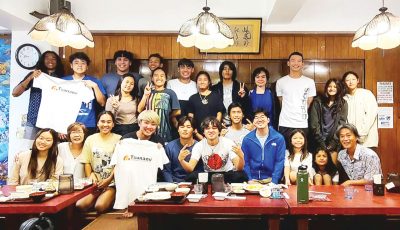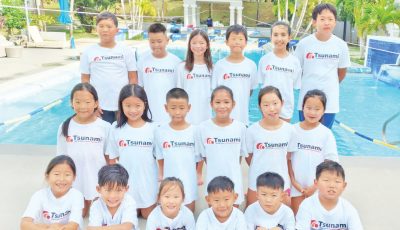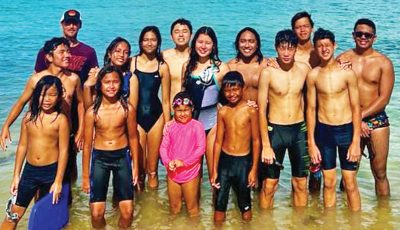Tsunami Saipan, SSC hold joint practices
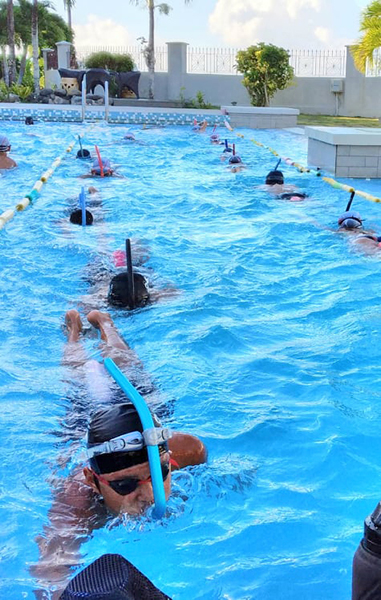
Swimming Center Tsunami Saipan and Saipan Swim Club swimmers perform front sculling drills with snorkel and paddle at a recent joint practice session. (Contributed Photo)
You can say the Triple Crown Open Water Swim Series was the beginning of a beautiful friendship for local swimming clubs Swimming Center Tsunami Saipan and Saipan Swim Club.
Not even 10 days after the finale of the qualifier for the 15th FINA World Swimming Championships in Abu Dhabi, United Arab Emirates, both clubs again shared the water this time in a non-competitive setting.
“Our first joint practice was Oct. 4. Tsunami Saipan coach Hiro [Kimura] and I met after the Triple Crown and he suggested I bring over some of our swimmers to their pool for a training session. Seeing the camaraderie of all the CNMI swimmers during the Triple Crown I thought that would be a great opportunity for the SSC swimmers to get some pool practice in while at the same time get a chance to hang out with their friends who swim with Tsunami Saipan,” said SSC coach Richard Sikkel.
The first combined practice between Tsunami Saipan and SSC swimmers turned out to be an long distance ocean practice which was pretty common place for the SSC swimmers, but an entirely different animal for the Tsunami Saipan swimmers. A week later SSC swimmers then joined Tsunami Saipan for a pool session, which Sikkel admitted was short and much more fast paced than SSC swimmers were used to.
Aside from building friendships between swimmers of both teams, joint SSC-Tsunami Saipan practices also had palpable benefits for the swimmers.
“The benefit is that the swimmers besides getting to enjoy time with their friends to get a taste of both worlds, longer endurance ocean swims and short fast-paced pool sessions. The swimmers have been very positive about the first few practices, they enjoy the different experience and change of scenery,” said Sikkel.
For Kimura, sharing the water with SSC swimmers was sort of a throwback to the time when both clubs used to practice and even competed against each other at the now mothballed Kan Pacific Swimming Pool in Marpi.
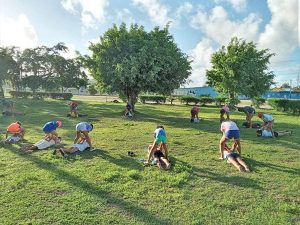
Swimmers do stretching exercises prior to another joint swimming practice in the open water this time. (Contributed Photo)
“When there was still a competition pool on this island, we could hold swim meets there and all swimmers would meet each other and swam together. They exchanged friendship there. It led to keeping young swimmers motivated during practices. Knowing each other, competing against each other, and talking with each other—these are very important facets of growing up,” he said.
The Tsunami Saipan coach added it just so happened that SSC’s long-distance open water swims is just what the doctor ordered for his wards.
“I planned to have some ocean practice since I hope to let Tsunami Saipan swimmers do endurance and distance contents more. So, joining SSC practices was a great opportunity for us. Their swimming course is set as straight 50m in the ocean. For increasing stamina and getting more endurance, it becomes good for Tsunami Saipan swimmers,” he said.
SSC swimmers taking part in Tsunami Saipan practices in the pool also has resulted in a sharing of swimming techniques.
“It helped them for turn techniques and follow-up drill workout to brush up their stroke. It would be great if each of them do make up the missing parts of their daily practices,” said Kimura.
Sikkel said joint practices is just the start as he envisions more partnerships with Kimura and Tsunami Saipan in the future.
“Coach Hiro and I discussed a few ideas for potential future races we can collaborate on. Since there aren’t too many options for off-island races at the moment it’s crucial that the clubs in collaboration with the Northern Marianas Swimming Federation take the lead in organizing events for our swimmers to test their skills.”
Kimura said it’s okay to have a lot of swim clubs on island and very much like football or baseball, he welcomes new swim clubs to join the fray.
“Our objective should be ‘One NMI!’ I believe our combined practice is the first step to achieving that goal.”




